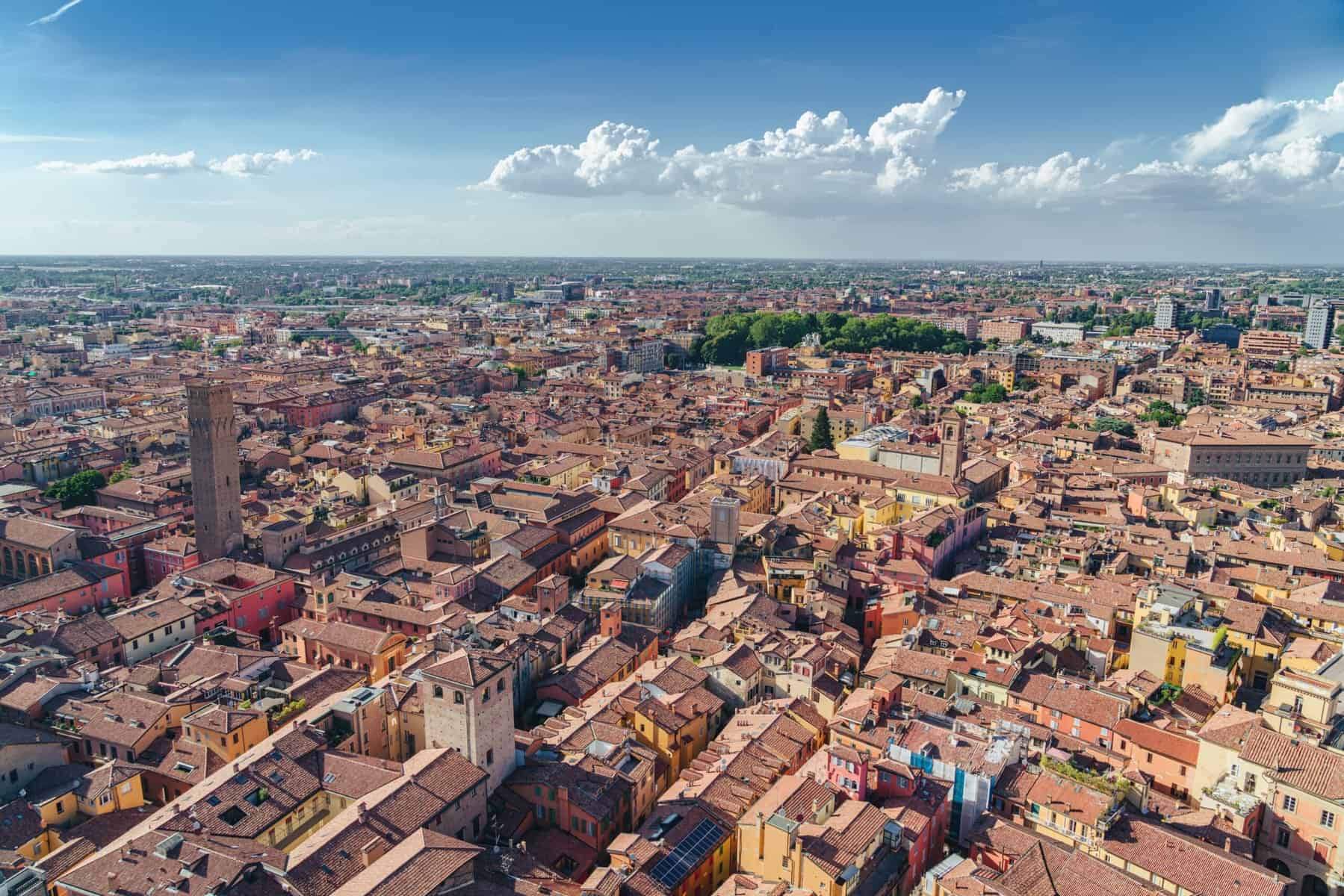
Best Things To Do in Bologna – Italy’s University City

Bologna is a must visit destination for anyone who loves history, architecture and eating the most delicious Italian food. But why specifically am I recommending Bologna, compared to the usual Italian city hotspots, well let me explain further.
Firstly, Bologna is home to the University of Bologna, among the world’s oldest educational institutions and one that holds the title of being the oldest university in continuous operation.
This prestigious institution was founded in 1088 by an organized guild of students, known as studiorum. This makes the university over nine centuries old, a testament to its enduring reputation and academic excellence. Just to give this ancient institution more context, the Aztec civilization, which is often considered ancient history, only began around 1325, several centuries after the University’s founding. Furthermore, the arrival of Christopher Columbus in the Americas occurred more than 400 years after the University of Bologna was already educating students. The University of Bologna’s historical significance is highlighted by this comparison, as it has been in continuous operation for a duration that surpasses the lifespans of numerous civilizations and significant historical events.
Along with this ancient university, the city is full of wonderful medieval architecture, beautiful squares and churches. But the allure doesn’t stop there – Bologna also holds the title of Italy’s gastronomic capital. Its renowned Bolognese cuisine and food scene provide an unparalleled culinary experience for food lovers. Eating in Bologna will for sure impress and satisfy your taste buds.
Finally, and another great reason for visiting Bologna is that this city is not as overrun with tourists as some other Italian cities. With fewer visitors, you’re in for a more genuine Italian experience; and who wouldn’t want to relish such an opportunity? This is why I so highly recommend visiting this Italian city.
So, now let’s begin to uncover all the best things to do in Bologna!
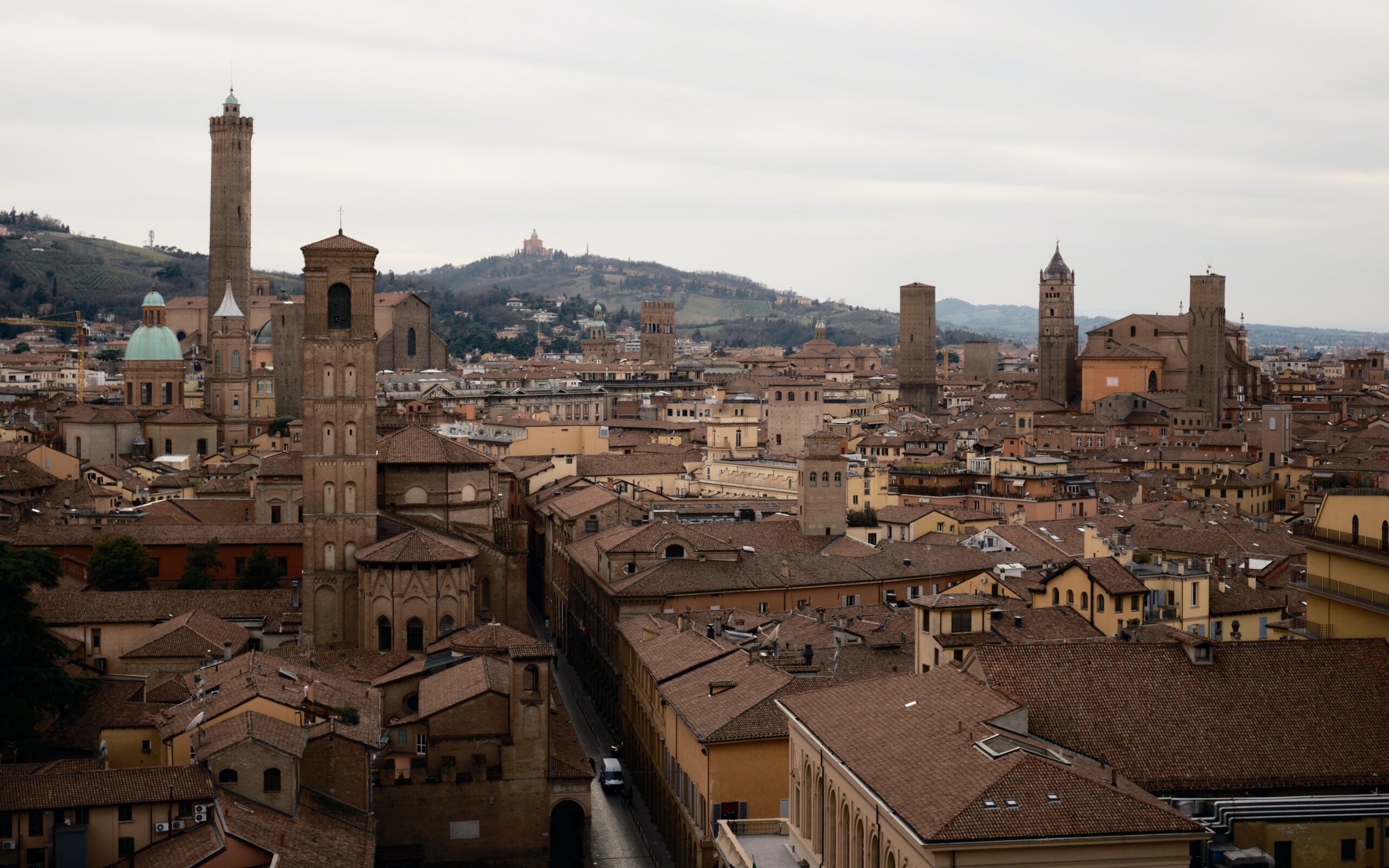
Visit the University of Bologna
The University of Bologna is one of the oldest universities in the world, founded in 1088, and is a great thing to do when visiting this city.
The University is centred around Via Zamboni, which is around a 10-15 minute walk east from the city’s historic centre.
When visiting, I recommend that you start from the Archiginnasio building, one of the most important parts of the University. This was the first official seat of the university.
Inside the building you will find the walls are decorated with inscriptions and coats of arms. It is here too you can visit the municipal library and anatomy theatre. Both highly worth visiting for their architecture and history.
Next visit the Palazzo Poggi (located on Via Zamboni) and today the headquarters of the university (since 1803). Once inside, you can admire the stunning frescoes, explore the historical collections, and wander through the beautifully preserved rooms. The collections in this building are dedicated to many subjects including, physics, chemistry, geography, nautical science and the military.
Visiting the University of Bologna is relatively straightforward. Access to the university is free from Monday to Saturday during daytime hours. Note that the university is closed on Saturday afternoons and Sundays.
The university has a number of self guided tours. which includes visiting a number of other university museums. For more information and access to the self-guided tours visit their website.
After you have explored the various university buildings and museums, make sure to wander the streets surrounding the university. Here you find many spaces and venues associated with student life including cafes, restaurants and bars.
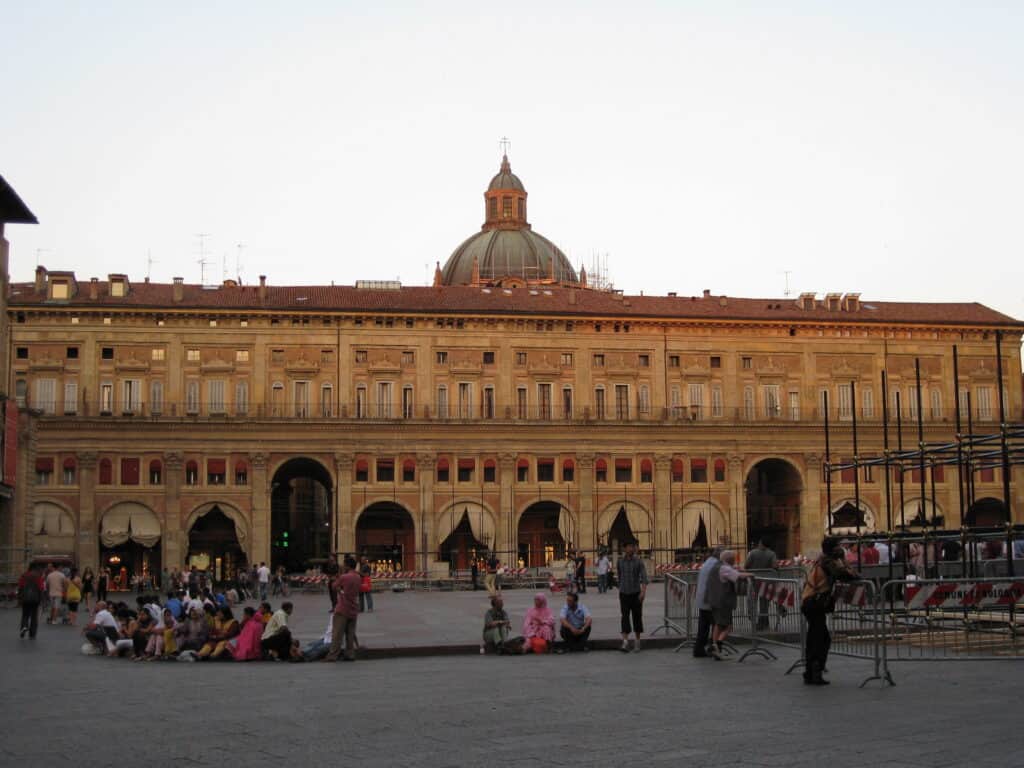
Visit Piazza Maggiore
This central square is not just a city landmark; it encapsulates the very essence of the city’s rich history and architectural grandeur.
Piazza Maggiore features the city’s most important buildings and is also dominated by the awe-inspiring Basilica of San Petronio.
Another key building on this piazza is the Palazzo d’Accursio (today known as the Palazzo Comunale), which served as the city’s Town Hall. This building is now open to the public and houses an art collection.
A few more notable buildings around this square include:
Palazzo dei Notai, once the headquarters of the notary guild, displaying the emblem of the guild on its facade.
Palazzo Re Enzo, was constructed between 1244 and 1246 and named after Enzio of Sardinia who was imprisoned here. The palace today is used for business conventions and local events.
Today Piazza Maggiore’s historical significance is indisputable. Starting out as the city’s main hub in medieval times, where citizens would gather to hear decrees and shop, today it continues to be a bustling hotspot for locals always brimming with life and activity.
Not only is the Piazza Maggiore a great place to spend time, this square and the area surrounding the square offer a number of great eating options, including including Bologna’s famous tortellini and tagliatelle al ragu.
Some great recommendations include:
Bar Vittorio Emanuele, dal 1882: This historic bar offers a charming atmosphere and has been serving delicious food since 1882.
Signorvino Bologna: Known for its excellent wine selection and Italian cuisine, this restaurant is a popular choice near Piazza Maggiore.
Trattoria Oberdan da Mario: Located close to Piazza Maggiore, this classic trattoria offers a friendly atmosphere and traditional dishes.
Ristorante da Nello: Situated very close to Piazza Maggiore, this classic restaurant is known for its friendly ambiance and delectable dishes.
Osteria del Sole: Just behind Piazza Maggiore, this characterful osteria (traditional eatery) is a favourite among locals.
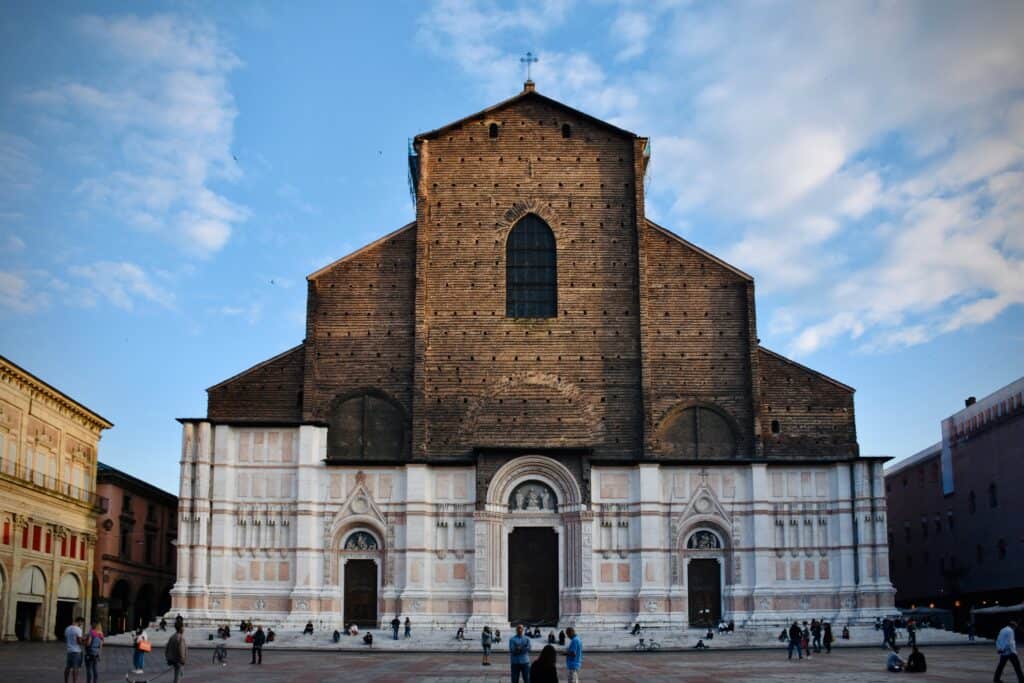
Visit Basilica di San Petronio
Basilica di San Petronio is one of Bologna’s most important churches and stands proudly on Piazza Maggiore.
Construction of the Basilica began in 1390 and dedicated to Bologna’s patron saint, Saint Petronius. While it may surprise you to learn that the facade of the church remains unfinished, this however doesn’t detract from its grandeur. Instead, it adds a certain charm and intrigue to the structure.
Inside, the Basilica is as awe-inspiring as its exterior suggests. It houses 22 chapels, each adorned with artworks by renowned Italian artists such as Jacopo di Paolo and Lorenzo Costa. The Basilica’s vast size and gothic style, with its high vaulted ceilings and stained-glass windows, create a sense of both enormity and serenity.
One of the most fascinating aspects of the Basilica di San Petronio is the unique combination of art, science, and religion found within its walls. In particular, the church is home to the world’s longest indoor sundial, a marvel of scientific ingenuity created by astronomer Giovanni Domenico Cassini in 1655. The sundial, stretching 67.7 metres along the floor, and was used to study the movements of the sun and contributed significantly to confirming the theories of Kepler regarding the elliptical orbits of planets.
The majority of the Basilica is free to visit and is open daily, The opening hours are generally from 7:45am-2:00pm and then from 3:00pm-6:30pm. It is important to note that during the services and mass, visiting the Basilica could be limited or suspended so always check out the website timetable in advance.
There are a numbers of areas in the basilica that have an entrance fee (Chapel Magi’s Chapel, Saint Sebastian’s Chapel and Saint Vincent Chapel). These areas are open daily, but have shorter visiting hours. Again check out the website timetable for the latest opening hours.
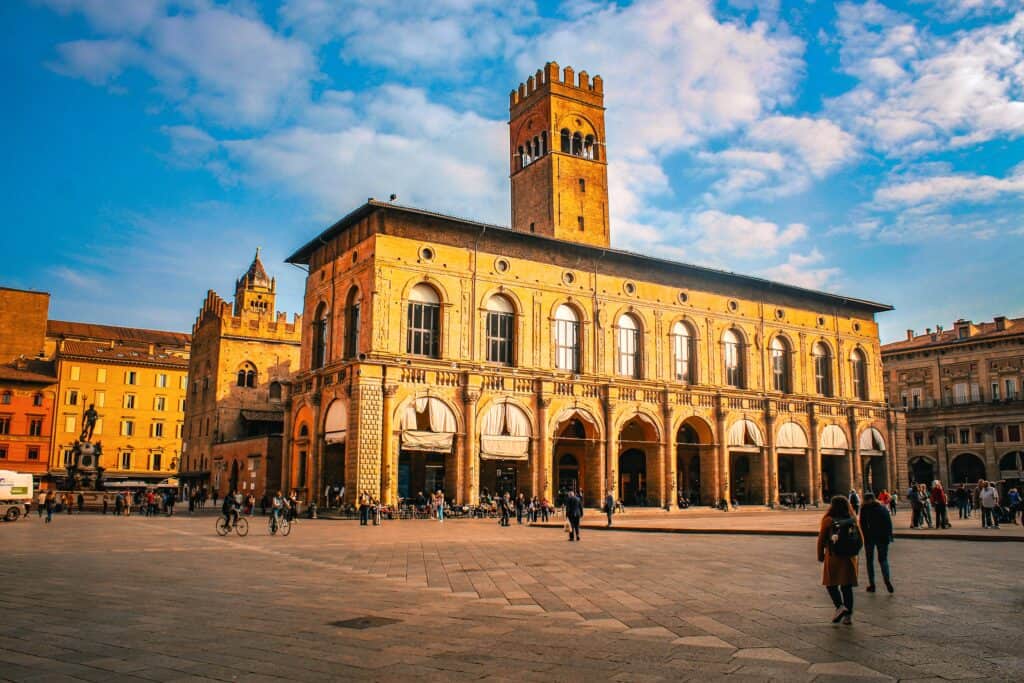
Tour Palazzo d’Accursio (Palazzo Comunale)
Situated on the western side of Piazza Maggiore the Palazzo d’Accursio has been the seat of the city government since 1336. The palace’s name, “d’Accursio,” comes from Accursius, a renowned jurist who lived in the building during the 13th century. Over the years, the palace has evolved into an amalgamation of architectural styles, reflecting the various periods it has witnessed.
Upon entering the Palazzo d’Accursio, you are greeted by an impressive number of halls, chapels and the impressive cordonata staircase. To note the cordonata staircase was originally designed for using on a horse.
Entrance to the main building (palazzo) is free. Week day opening hours are 9am-6:30pm and Saturday & Sundays between 10am-6:30pm.
In addition to the main rooms of the Palazzo, you can also climb the Clock Tower and visit the Municipal Art Collection (on the second floor). Entrance tickets are required for both the clock tower and art collection and can be purchased at the office or online in advance.
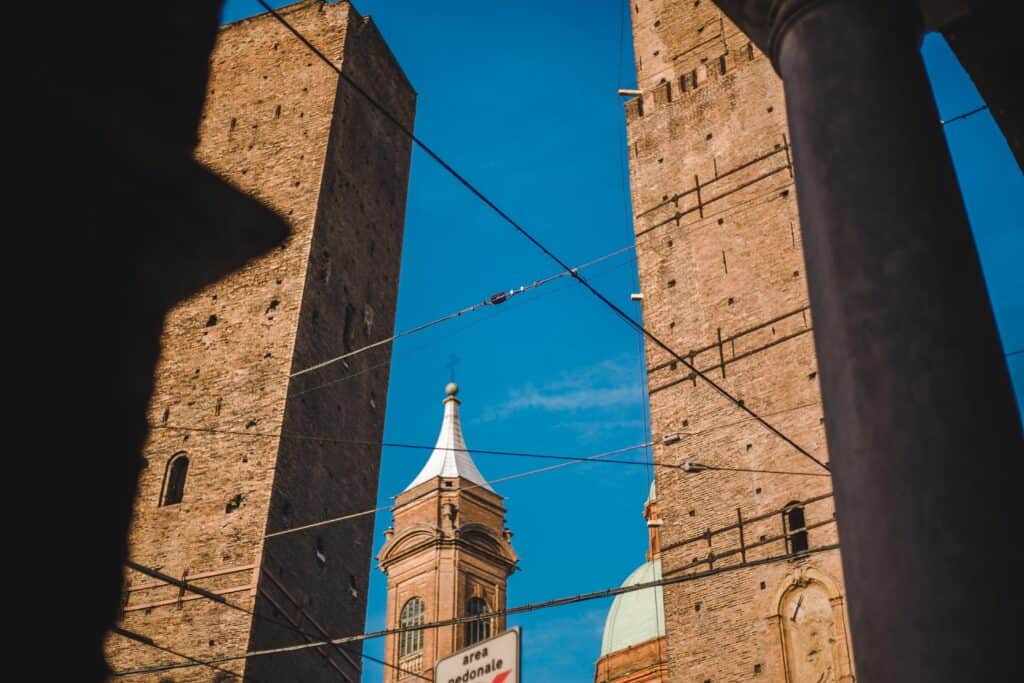
Visit The Two Towers
In the heart of Bologna two iconic towers pierce the sky, standing as symbols of the city’s rich medieval past – known as Le Due Torri or The Two Towers.
The Two Towers, individually called Asinelli and Garisenda are located at the entrance of the ancient Via Emilia, a significant trade route during Roman times. The taller of the two, the Asinelli Tower, stands proudly at 97.2 metres, while its sibling, the Garisenda Tower, has a height of 48 metres.
The towers were constructed in the 12th century by the families whose names they bear. Initially built for defensive purposes and as status symbols among the aristocracy, the towers today are a must-visit tourist attraction.
A visit to the top of the Asinelli Tower is one of the best things to do when visiting Bologna. After climbing its nearly 500 steps, you are rewarded with a breathtaking panoramic view of the city, from its red-tiled rooftops to its bustling streets below.
Although Garisenda Tower is not open to the public due to its significant lean, it still commands attention and admiration. Its tilt, even more pronounced than that of the famous Leaning Tower of Pisa, adds a unique charm to Bologna’s skyline.
When visiting Bologna, make sure to carve out time to visit these medieval structures. Whether you’re soaking up the views from the top of Asinelli or marvelling at the lean of Garisenda from below, the Two Towers are a wonderful part of the city’s medieval skyline.
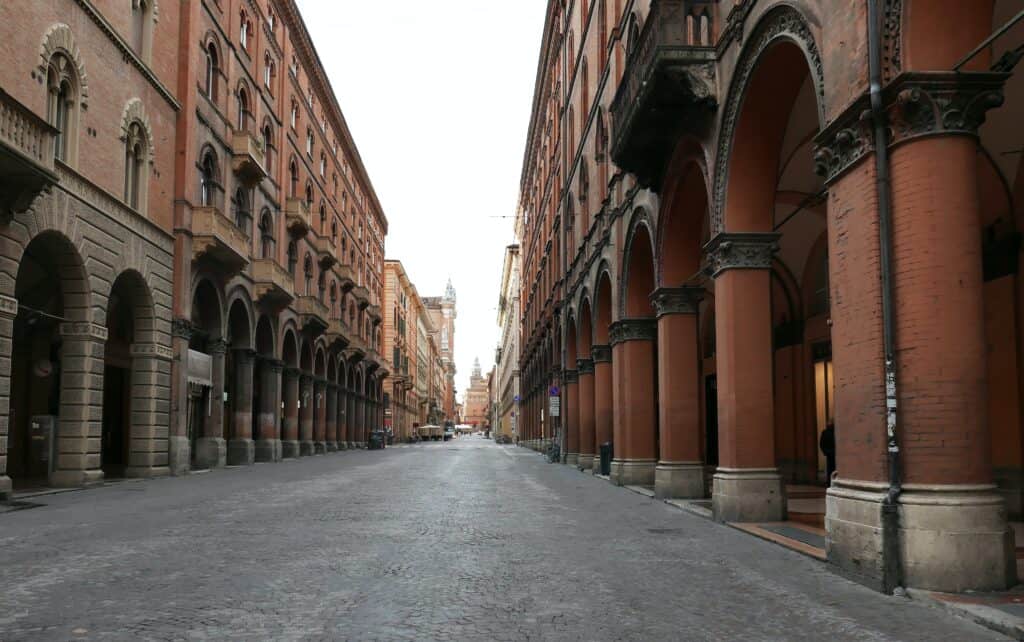
Walk Under The Porticoes
The porticoes of Bologna (are also a UNESCO World Heritage Site) span almost 62 kilometres around the city and have 40 kilometres in the historic centre alone. These covered walkways are unique to Bologna and are the most ‘arcaded’ city in Italy. Among these, the Portico of San Luca stands out as the longest and most famous, stretching 3,796 metres with 666 arches. These architectural masterpieces not only offer shelter but also serve as lively spaces adorned with shops, cafes, and restaurants. A great way to wonder and explore the city.
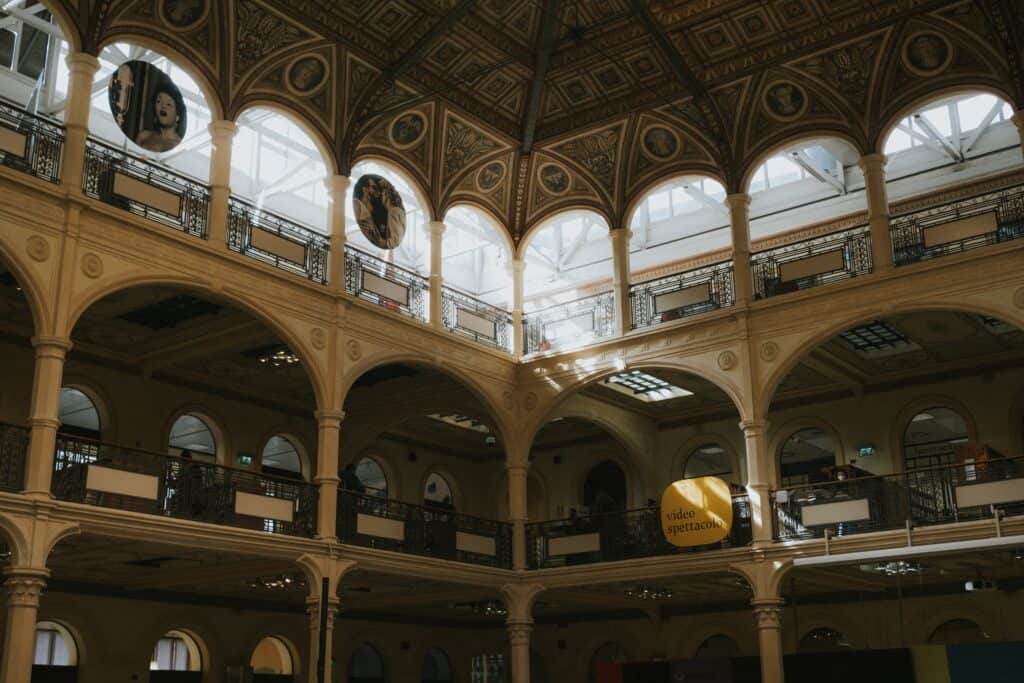
Check Out Bologna’s Indoor Square – Piazza Coperta
Piazza Coperta is an indoor square that serves as a meeting place and cultural hub. This square is part of the Sala Borsa complex and named after Umberto Eco, a renowned professor at the University of Bologna.
Underneath this covered square, archaeological excavations have revealed fascinating remnants of Bologna’s past. These excavations can be seen from the glass floor that covers the the square. However the excavation site is also open to the public and can be visited via an informal guided tours (that generally take place on Fridays), however reservations are required in advance. (Contact bibliotecasalaborsa @ comune.bologna.it to make arrangements).
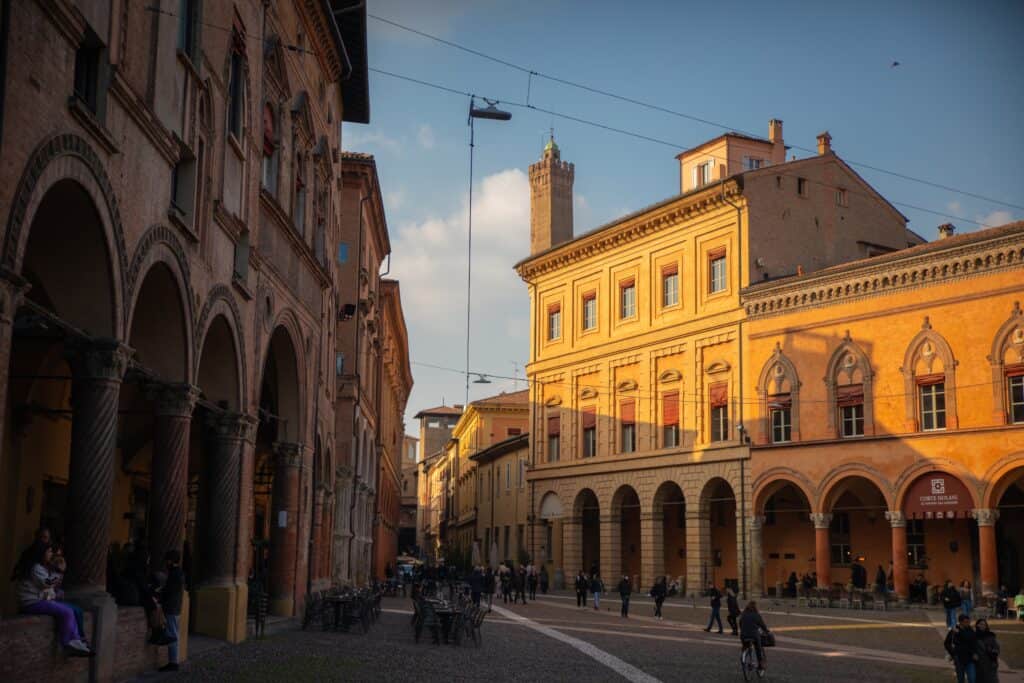
Stroll Along Via Indipendenza
Via Indipendenza is one of Bologna’s main shopping streets and a great place to spend time browsing shops or grabbing a bite to eat at one of its many restaurants or cafes. .
Visit The City’s Museums
Bologna has a number of great museums to visit each offering an insight into the different facets of the city’s history, art, and culture.
Some of the best museums to visit include:
Ducati Museum: For motorbike enthusiasts and history buffs, the Ducati Museum is a must-visit. Here, you can feast your eyes on historical Ducati masterpieces, ranging from small bikes to retro models. The museum is located at Via Antonio Cavalieri Ducati, 3.
Museo della Storia di Bologna: This museum provides a fascinating exploration of Bologna’s rich history. located at Via Castiglione, 8.
MAMbo – Modern Art Museum in Bologna – Art lovers should not miss the MAMbo, the Modern Art Museum in Bologna. The museum showcases a wide range of contemporary art pieces, located at Via Don Minzoni.
Pinacoteca Nazionale – The Pinacoteca Nazionale houses an impressive collection of Renaissance paintings and is a must-see for any art aficionado. It’s located at Via Belle Arti, 56.
The Museo Civico Archeologico – Also known as the Archaeological Civic Museum, is housed in the 15th-century Palazzo Galvani which adds to its charm and allure. The museum is a treasure trove of archaeological artefacts and relics, offering visitors a glimpse into the rich and diverse history of the region. It’s conveniently located in the heart of the city, close to Piazza Maggiore.
Spend An Evening At Teatro Comunale di Bologna
Teatro Comunale di Bologna (also known as Teatro Manzoni) is one of Italy’s oldest opera houses dating back to 1763 when it first opened its doors . The theater hosts regular performances featuring both international & local acts ranging from ballet & classical music concerts to theatrical productions.
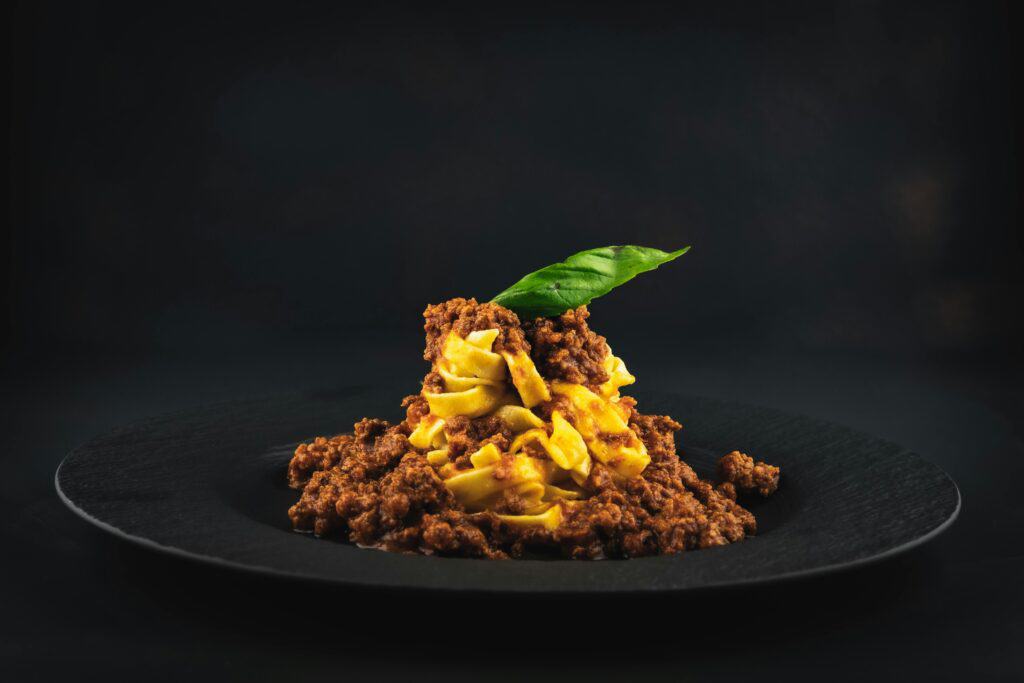
Enjoy The Incredible Food
When it comes to Italian cuisine, Bologna is a city that stands out. Known as “La Grassa” (The Fat One), Bologna is famous for its rich and sumptuous culinary traditions. From tortellini to ragù, the city is a paradise for food lovers and the country’s gastronomic capital. Here are some of the best places to eat in Bologna that you simply cannot miss.
Trattoria di Via Serra – If you’re looking for an authentic Bolognese experience, Trattoria di Via Serra should be on your list. This family-run restaurant serves traditional dishes made with locally-sourced ingredients. Don’t miss their tagliatelle al ragù – a classic that will make your taste buds sing.
Osteria dell’Orsa – A rustic eatery known for its hearty meals and cozy ambiance. Try their lasagna verde, a delightful dish layered with spinach pasta, béchamel sauce, and ragù. It’s a true Bolognese comfort food.
Da Cesari – Da Cesari is a must-visit for foodies seeking the best seafood in town. This upscale restaurant is renowned for its fresh fish and shellfish dishes. Make sure to try their grilled octopus and seafood risotto, paired perfectly with a glass of white wine.
Drogheria della Rosa – For a unique dining experience, head over to Drogheria della Rosa. Housed in a former pharmacy, this restaurant serves delicious food in a quirky setting. Their pumpkin tortellini and panna cotta are certainly worth trying.
Pizzeria Due Torri – No trip to Italy is complete without pizza, and Pizzeria Due Torri is one of the best in Bologna. Their wood-fired pizzas are thin, crispy, and loaded with toppings. The ‘Due Torri’ specialty pizza with mozzarella, ham, mushrooms, and olives is a crowd favorite.
For the more great information about eating and drinking in Bologna, read This Best Food And Wine Tours blog.
Eat Delicious Gelato
Finally, there is no better way than to experience the true essence of Italian sweetness than to indulge in a scoop (or two) of authentic Italian gelato. And when it comes to gelato, Bologna is a city that prides itself on providing some of the best. Let’s embark on a delicious journey to discover the top gelaterias in Bologna.
Cremeria Santo Stefana – This centrally located gelateria is loved for its exceptional flavors and creamy textures. From traditional vanilla to more adventurous choices, every scoop is a delight.
La Sorbetteria Castiglione – Another must-visit gelateria in the heart of Bologna. Known for their high-quality ingredients and a wide variety of flavors, this place will surely satisfy your sweet tooth. Don’t miss their signature flavors like Pistachio and Dark Chocolate.
Gelateria Galliera 49 – Is a gem that shines brightly among Bologna’s gelaterias. Their gelato is made fresh daily and the flavor range is impressive. Try their unique flavors like Ricotta and Figs or Mascarpone and Nutella.
Cremeria Cavour – A go-to place for those who love classic flavours. This small but charming gelateria offers some of the creamiest and most flavorful gelato in town. Be sure to sample their Stracciatella or Hazelnut flavors.
Stefino Gelato Biologico – A must-visit for great organic and vegan options. Their gelato is made from organic ingredients and their vegan chocolate and almond flavours are crowd favourites.
Cremeria Scirocco – Is another top-rated gelateria that deserves a mention. They offer a wide range of flavors, all made with high-quality ingredients. Their Pistachio and Tiramisu flavors are not to be missed.
For great information about eating gelato, read our Gelato The Ultimate Guide blog.
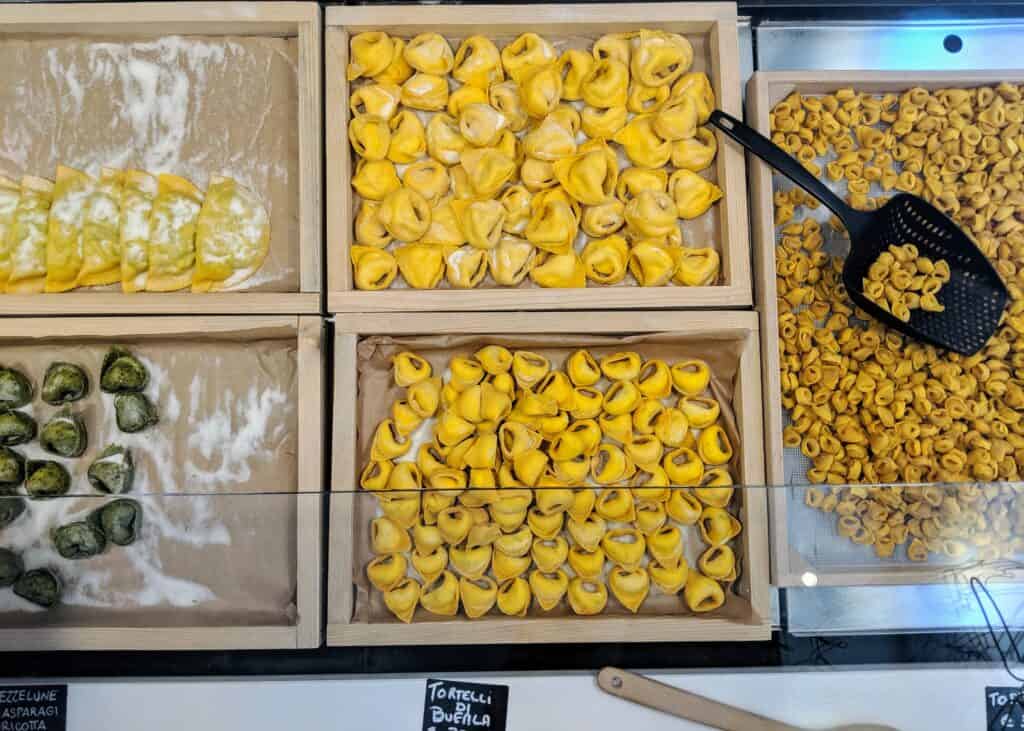
Visit Mercato Di Mezzo
Mercato Di Mezzo (also known as Middle Market) has been around since at least 1230 when it first began trading food items like fruit, vegetables, cheese, meat & fish. Today it still serves these same items plus many other goods including clothing , shoes , jewellery & souvenirs making it a great place if you are looking for unique gifts or just something special for yourself.
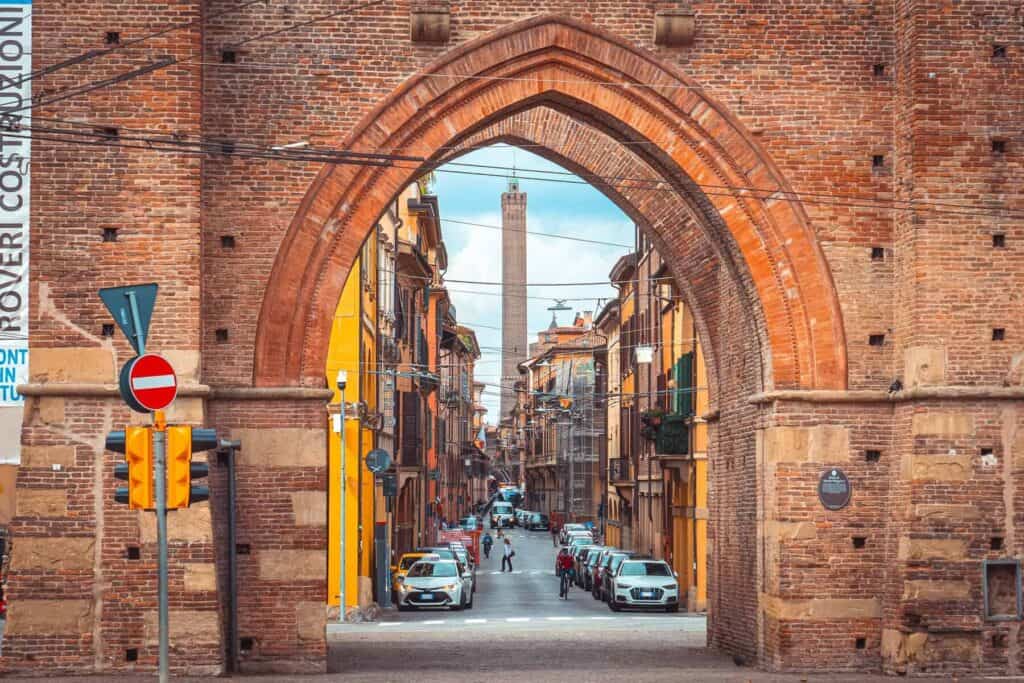
To Wrap Up On the Best Things To Do In Bologna…
To conclude, Bologna is a city that truly has something for everyone. Whether you’re a history buff, a foodie, or an art lover, the city’s rich heritage, culinary delights, and vibrant culture are sure to captivate you. From exploring the medieval city streets, porticoes, university and enjoying the most delectable cuisine, there’s no shortage of memorable experiences to be had in this charming university city.
For an insight into another vibrant university city, explore our great blog post about the Best Things To Do in Salamanca, Spain’s Golden City!
Further FAQs:
How To Get To Bologna
There are several ways to reach the city of Bologna.
By air: Bologna’s Guglielmo Marconi airport is conveniently located about 10 km from the city centre. Dozens of flights are scheduled daily from many international destinations and other Italian cities.
By Train: Bologna can be easily reached by train from many major cities in just a couple of hours. The city’s main train station, Bologna Centrale, is also very central located a close to many of the popular tourist attractions.
By Road: Driving to Bologna can be a great way to experience the beautiful Italian countryside. The city is easily accessible from many major cities in Italy as it is connected to the rest of Italy by an extensive network of motorways.
However, it is worth noting that Bologna has a Limited Traffic Zone (ZTL) in its historic centre, where only authorised vehicles are allowed. Be sure to plan your parking ahead of time, as on-street parking can be challenging to find. There are several parking lots and garages around the city where you can leave your car and explore the city on foot or by public transport.
When To Go To Bologna
SpringSpring (April – June) – Is often considered one of the best times to visit Bologna. The city comes alive after the quieter winter months, with temperatures that are comfortable but not too hot, making it perfect for exploring the city’s historic sites and open spaces.
Summer (June – August) – Can be quite hot and humid and also keep in mind that this is the peak tourist season in Italy, so attractions will be more crowded.
Autumn/Fall (September – November) – Is also a great time to visit Bologna, especially for foodies. The harvest season brings an abundance of fresh produce, and the city’s culinary scene truly shines. The temperatures begin to cool, making it an ideal time to enjoy outdoor activities and the city’s stunning fall foliage.
Winter (December – February) – Winter is the season of celebration for Bolognese food. Traditional dishes like tortellini and cotechino take centre stage, making it a great time for culinary enthusiasts to visit. The weather can be chilly, but the city’s warm and cozy restaurants provide the perfect respite.
Annual Events in Bologna – Bologna hosts a variety of annual events that cater to different interests. In January, there’s Arte Fiera, one of Italy’s most significant contemporary art exhibitions. Film lovers should plan to visit in June for Il Cinema Ritrovato, an international film festival. In November, the city celebrates its culinary heritage with Bologna Food Week, featuring tastings and cooking classes.
How Much Time To Spend In Bologna
Depending on the pace of travel you prefer, at least 3 days is recommended to be able to explore and visit all the best things to do in the city.
Where To Stay In Bologna
Bologna has many hotel options, here are some options I recommend:
Disclosure: Please note that some of the hotel links below are affiliate links. At no extra cost to you, we earn a small commission from each booking that allows us to help maintain this website.
Luxury Hotels:
Grand Hotel Majestic gia’ Baglioni: Known for its elegance and top-notch service, this hotel is housed in an 18th-century palazzo.
Hotel Corona d’Oro: This hotel offers refined rooms and excellent service, making your stay a memorable one.
Phi Hotel Bologna: A luxurious stay that blends comfort with class.
Hotel Touring: With its prime location and exclusive amenities, it’s a popular choice among luxury seekers.
Aemilia Hotel Bologna: Known for its modern amenities and rooftop terrace offering stunning city views.
Boutique Style & Budget-Friendly Hotels:
Casa Isolani: This budget-friendly option doesn’t compromise on quality or comfort.
Villa Benni B&B: A charming bed & breakfast that offers a cozy stay.Hotel Roma: A boutique hotel that provides a unique blend of affordability and style.
Mitico Hotel & Natural Spa: A great option if you are after spa and fitness facilities. Slightly away from the centre.
Relais Bellaria Hotel & Congressi: A cost-effective option with modern amenities and a convenient location.

